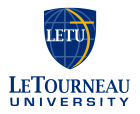Below is a summary of the abstract you submitted. Presenting author(s) is shown in bold.
If any changes need to be made, you can modify the abstract or change the authors.
You can also download a .docx version of this abstract.
If there are any problems, please email Dan at dar78@pitt.edu and he'll take care of them!
This abstract was last modified on March 28, 2023 at 11:31 a.m..

The isolation and analysis of bacteriophage genomes and gene products can facilitate the development of novel molecular tools to study these important biological entities, and the identification of novel therapeutic phage-derived proteins or phage cocktails to combat the current existential threat of antibiotic resistance. Since joining the SEA-PHAGES program in 2015, LeTourneau University students have isolated 114 phages, 37 of which have been sequenced. This study examined the diversity of the bacteriophages isolated in East Texas over the years 2021-2022. During this period, 19 phages were isolated using Mycobacterium smegmatis mc2 155 as a host, 8 of which were sequenced. Modified enriched isolation and DNA extraction methods were used, which resulted in a high (>85%) phage isolation and 100% DNA extraction success rates these past two years. Despite the proximity of the soil sampling sites and the same phage isolation host and protocols used over the study period, differences were observed in morphotypes, life cycles, G+C content, number of tRNA’s, and genome sizes of the sequenced phages. Collectively, the 8 sequenced phages were classified across five subclusters, namely A4, A11, C1, M1, and P1. Even within the same subcluster, differences were observed between the individual phages, showcasing the biodiversity among the genomes. The G+C content for 2021 averaged ~64.3%, which was slightly higher than that of 2022, at ~62.2%. The average genome size for 2021 (83,844 bp, range 46,673 - 155,280 bp) was also higher than that of 2022 (73,072 bp, range 51,055-81,156 bp). All the phages were temperate, except Ikeloa, which had a lytic life cycle. All the temperate phages had the Siphoviridea morphotype, while the lytic Ikeloa had a Myoviridea morphotype. The observed diversity of these phages isolated from the same area using the same method exemplifies the abundant genetic diversity typical of bacteriophages and their ability to adapt and change within a given environment. In future work, more phages should be isolated from diverse areas to provide large-scale phage isolates and genome catalogs which will potentially be mined for novel therapeutic cocktails, genes, and gene products for various beneficial uses.



